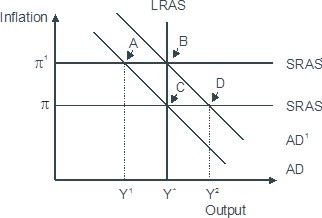Predatory pricing involves a firm
a. colluding with another firm to restrict output and raise prices.
b. selling two individual products together for a single price rather than selling each product individually at separate prices.
c. temporarily cutting the price of its product to drive a competitor out of the market.
d. requiring that the firm reselling its product do so at a specified price.
c
You might also like to view...
Based on the figure below. Starting from long-run equilibrium at point C, an increase in government spending that increases aggregate demand from AD to AD1 will lead to a short-run equilibrium at point ________ creating _____gap. 
A. D; an expansionary B. B; no output C. B; expansionary D. A; a recessionary
Which of the following is a determinant of supply?
A) tastes and preferences of consumers B) technology C) consumer income D) number of consumers
From 1978 to 2003, China grew on average ________ percent per year, a rate faster than any other country in the world.
A. 4 B. 9 C. 25 D. 75
Grace Makutsi finally bought a pair of blue shoes that she had been coveting for a long time. In less than a week she discovered that the shoes were uncomfortable. Grace went back to wearing her old pair and stashed away the new pair. When asked by her
boss, Mme. Ramotswe, why does she not simply give away the new pair, she said: "But I paid so much for them." Grace's behavior A) is rational: she should not discard a valuable item. B) ignores the fact that the purchase price is now a sunk cost and has no bearing on whether she should give them away or not. C) supports the endowment effect which states that ownership of an item makes it more valuable. D) is rational because the more you pay for an item the more valuable it is.